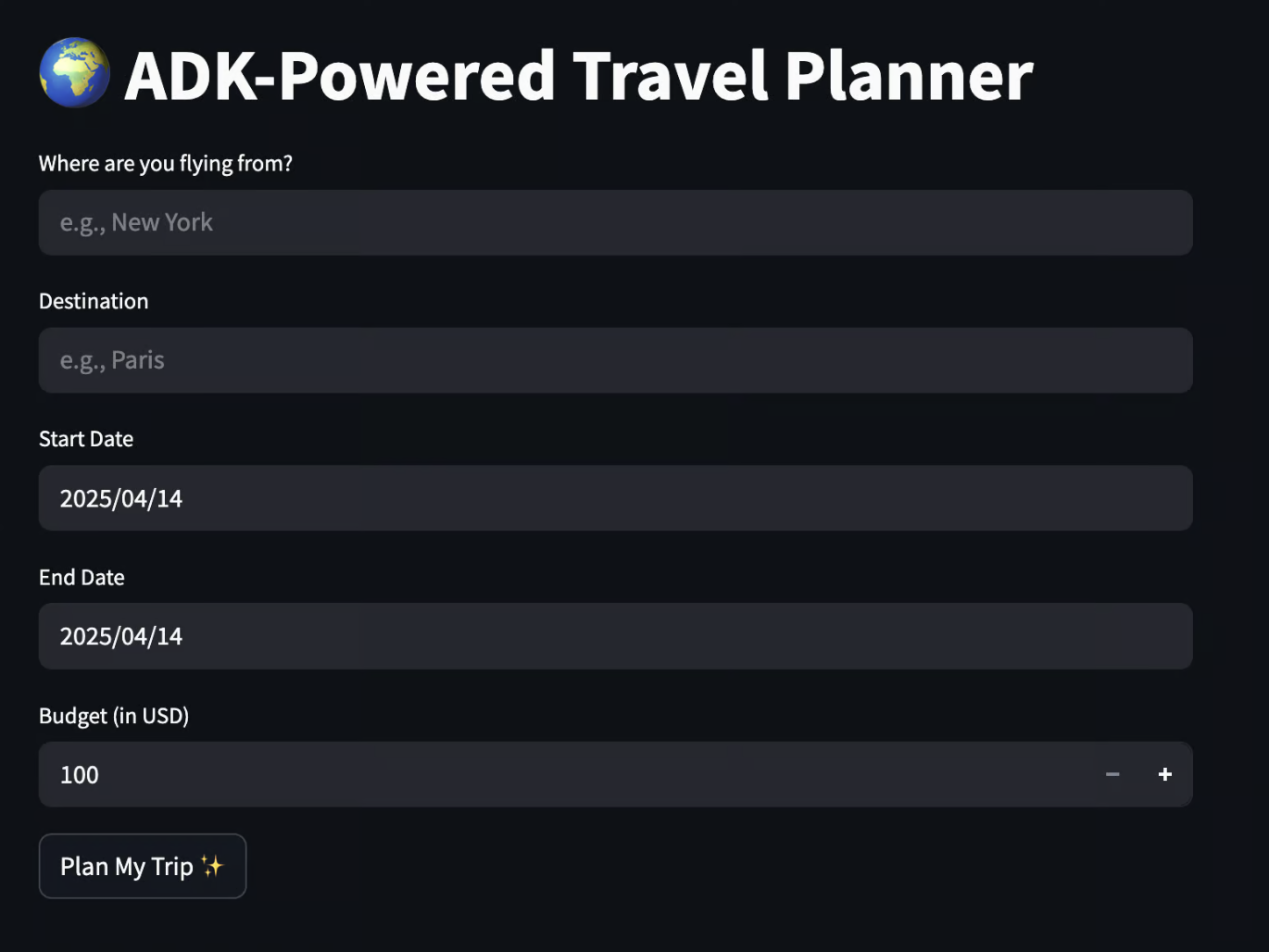Read the full article on DataCamp: Google’s Agent Development Kit (ADK) – A Guide With Demo Project
Learn how to build a multi-agent travel assistant using Google’s ADK and the Agent2Agent (A2A) protocol with FastAPI and Streamlit.
Google’s Agent Development Kit (ADK): A Guide With Demo Project
Learn how to build a multi-agent travel assistant using Google’s Agent Development Kit (ADK) and the Agent2Agent (A2A) protocol.
Apr 14, 2025 · 12 min read
Contents
- What Is Google’s Agent Development Kit (ADK)?
- Project Overview: AI-Powered Travel Planner With ADK and A2A
- Step 1: Prerequisites
- Step 2: Shared Schema and Utilities
- Step 3: Building the Multi-Agent System with ADK and A2A
- Step 4: Coordinating with host_agent
- Step 5: Building the UI With Streamlit
- Conclusion
What Is Google’s Agent Development Kit (ADK)?
Google’s ADK is a modular, production-ready framework for building LLM-powered agents used in real-world Google products. It enables structured, model-agnostic, multi-agent systems with powerful orchestration, memory, and streaming capabilities.
Key Features
- Multi-agent by design: Compose agents in parallel, sequential, or hierarchical flows.
- Model-agnostic: Compatible with Gemini, GPT-4o, Claude, Mistral (via LiteLlm).
- Streaming-ready: Supports bidirectional real-time interactions.
- Deployment-ready: Easily containerized for platforms like GCP or Railway.
What is Google’s Agent2Agent (A2A) Protocol?
A vendor-neutral HTTP-based protocol to enable communication between AI agents. Agents expose /run endpoints and .well-known/agent.json for metadata, supporting interoperability with orchestrators like LangGraph or CrewAI.
Project Overview: AI-Powered Travel Planner With ADK and A2A
This demo uses:
flight_agent: Suggests flightsstay_agent: Suggests hotelsactivities_agent: Suggests activitieshost_agent: Orchestrates themstreamlit_app.py: Frontend UI
All agents run independently and communicate via HTTP using A2A-compatible endpoints.
Step 1: Prerequisites
pip install google-adk litellm fastapi uvicorn httpx pydantic openai streamlit
export OPENAI_API_KEY="your_key_here"
Step 2: Shared Schema and Utilities
shared/schemas.py
from pydantic import BaseModel
class TravelRequest(BaseModel):
destination: str
start_date: str
end_date: str
budget: float
common/a2a_client.py
import httpx
async def call_agent(url, payload):
async with httpx.AsyncClient() as client:
response = await client.post(url, json=payload, timeout=60.0)
response.raise_for_status()
return response.json()
common/a2a_server.py
from fastapi import FastAPI
def create_app(agent):
app = FastAPI()
@app.post("/run")
async def run(payload: dict):
return await agent.execute(payload)
return app
Step 3: Building the Multi-Agent System
Folder Structure
agents/
├── host_agent/
├── flight_agent/
├── stay_agent/
└── activities_agent/
Example Agent (activities_agent/agent.py)
from google.adk.agents import Agent
from google.adk.models.lite_llm import LiteLlm
activities_agent = Agent(
name="activities_agent",
model=LiteLlm("openai/gpt-4o"),
description="Suggests activities at the destination",
instruction="Suggest 2-3 activities based on destination, dates, and budget."
)
Runner Setup & execute() Logic
from google.adk.runners import Runner
from google.adk.sessions import InMemorySessionService
session_service = InMemorySessionService()
runner = Runner(agent=activities_agent, app_name="activities_app", session_service=session_service)
async def execute(request):
prompt = f"...construct using request..."
# Stream and parse structured JSON output
Step 4: Coordinating with host_agent
host_agent/task_manager.py
from common.a2a_client import call_agent
async def run(payload):
flights = await call_agent("http://localhost:8001/run", payload)
stay = await call_agent("http://localhost:8002/run", payload)
activities = await call_agent("http://localhost:8003/run", payload)
return {
"flights": flights.get("flights", "..."),
"stay": stay.get("stays", "..."),
"activities": activities.get("activities", "...")
}
Step 5: Building the UI With Streamlit
streamlit_app.py
import streamlit as st, requests
st.title("ADK-Powered Travel Planner")
# Input form ...
if st.button("Plan My Trip ✨"):
payload = {...}
response = requests.post("http://localhost:8000/run", json=payload)
# Display flights, stays, activities
Run the Complete System
uvicorn agents.host_agent.__main__:app --port 8000 &
uvicorn agents.flight_agent.__main__:app --port 8001 &
uvicorn agents.stay_agent.__main__:app --port 8002 &
uvicorn agents.activities_agent.__main__:app --port 8003 &
streamlit run streamlit_app.py
Final File Structure
ADK_demo/
├── agents/
│ ├── host_agent/
│ ├── flight_agent/
│ ├── stay_agent/
│ └── activities_agent/
├── common/
│ ├── a2a_client.py
│ └── a2a_server.py
├── shared/
│ └── schemas.py
├── streamlit_app.py
├── requirements.txt
└── README.md
Conclusion
This demo shows how to use Google’s ADK and A2A protocol to build scalable, modular multi-agent systems using LLMs. Agents run independently, communicate using HTTP and schemas, and are orchestrated into a seamless experience using Streamlit.
🔗 A2A GitHub
🔗 Build a Weather Bot with ADK
🔗 Agent Development Kit


Comments